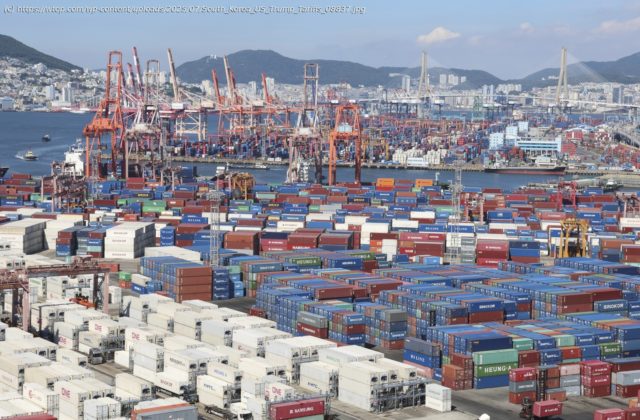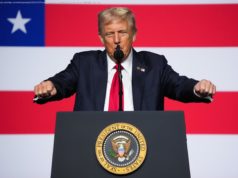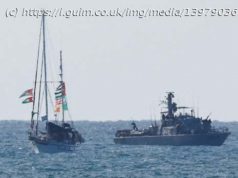President Donald Trump signed an executive order Thursday that would have new tariffs on a wide swath of U.S. trading partners to go into effect in seven days…
President Donald Trump signed an executive order Thursday that would have new tariffs on a wide swath of U.S. trading partners to go into effect in seven days — the next step in his trade agenda that will test the global economy and alliances.
The order was issued shortly after 7 p.m. It came after a flurry of tariff-related activity in recent days, as the White House announced agreements with various nations and blocs ahead of Trump’s self-imposed Aug. 1 deadline.
Also on Thursday, Trump announced that he would be extending trade negotiations with Mexico for 90 days. But the vast majority of nations are continuing to face uncertainty ahead of the coming deadline. And while a handful of trade deals have also trickled in, many details remain hazy — with businesses and manufacturers around the world bracing for heightened operating costs and potential price hikes regardless.
Meanwhile, Trump’s overhaul of American trade policy hasn’t gone unchallenged. Appellate court judges have expressed broad skepticism around Trump’s legal rationale for his most expansive round of tariffs.
Here’s the Latest:
Australian Trade Minister Don Farrell says gaining the minimum U.S. tariff on exports including beef, lamb, wine and wheat gave Australia a competitive advantage over some competitors.
Farrell told reporters Australia did not introduce tariffs on U.S. goods at any point, and added, “I haven’t seen any case or any example where the retaliatory imposition of tariffs has resulted in a country being in a better position.”
Farrell argues that no U.S. tariffs can be justified because Australia imposes no tariffs on its bilateral free trade partner. The United States has enjoyed a trade surplus with Australia for decades.
Australian Prime Minister Anthony Albanese has been criticized for failing to secure a face-to-face meeting with Trump to discuss trade.
Japanese Chief Cabinet Secretary Yoshimasa Hayashi welcomed Trump’s signing of the executive order setting Japan’s new reciprocal tariffs as a step that would reduce uncertainty of the U.S. trade policy and its negative impact on the global economy, including that of Japan.
Hayashi, however, said Japan still needs to closely examine the measures and continue urging prompt implementation by the U.S. government to carry out the agreement, including reduction of tariffs on automobiles and auto parts.
Hayashi acknowledged that Japan’s new tariff rate of 15% is a “major reduction” from the initially imposed 25%, but his government will continue to watch and mitigate its impact on Japanese exports, including by providing financial assistance for small and medium-sized businesses.
New Zealand officials said they would lobby the administration for a change to the 15% tariff announced for the country’s exporters to the U.S. It’s an increase from the original 10% baseline announced for New Zealand in April.
“We don’t think this is a good thing. We don’t think it’s warranted,” Trade Minister Todd McClay told Radio New Zealand Friday. He said New Zealand appeared to have been targeted for a larger levy because the country records a trade deficit with the U.S. but that the gap of about half a billion dollars each year was “not significant or meaningful.”
Neighboring Australia dodged an increase to remain at 10%, but it records a trade surplus with the U.S., McClay added.
The United States in January overtook Australia to become New Zealand’s second-largest export partner, behind China. New Zealand exports are largely made up of meat, dairy, wine and agricultural machinery.
Taiwan’s president Lai Ching-te said Taiwan had yet to engage in final negotiations with the U.S. due to scheduling difficulties and that he was hopeful the final tariff rate would be reduced even further after a final round of talks.
The Trump administration initially hit Taiwan with 32% tariffs but lowered it to 20% Thursday.
Negotiations have included talks on working together on high-tech supply chains, Lai said in his statement. The U.S. is Taiwan’s most important export market and strategic ally, he added.
Cambodia Prime Minister Hun Manet expressed his thanks to Trump for the dropping of tariffs from 36% to 19% and he called the reduction “good news” for Cambodia.
Posted on his social media platform, Hun Manet said Trump had not only helped broker a ceasefire between Cambodia and Thailand forces after nearly a weeklong clash but also helped Cambodia’s economy by lowering tariffs.
“This is good news for the people and economy of Cambodia to continue developing the country,” Hun Manet said.
Thailand’s government spokesperson Jirayu Houngsub said Thailand says the U.S. agreed to reduce the tariffs rate from 36% to 19%, a rate similar to those imposed on many other Southeast Asian countries such as Vietnam and the Philippines.
“It’s one of the major successes of Team Thailand in a win-win approach, to secure the country’s export base and economic security in a long run,” he said in a statement. He didn’t immediately say what was the latest offer Thailand made to the U.S.
The agreement came days after a ceasefire between Thailand and Cambodia to halt the nearly weeklong clashes that killed at least 41 people. It was brokered with U.S. pressure as Trump said he would not move forward with trade agreements if the conflict continued.
___
This item has been updated to correct that Vietnam has a similar tariffs rate to that of Thailand at 20%, but not the same rate at 19%.
After initially threatening the African nation of Lesotho with a 50% tariff, the country’s goods will now be taxed at 15%.
Taiwan will be tariffed at 20%, Pakistan at 19% and Israel, Iceland, Fiji, Ghana, Guyana and Ecuador among the countries with imported goods taxed at 15%.
The tariffs will go into effect Aug. 7, not the Friday deadline that the president had set. The reason for this is the government needs time to harmonize the tariff rates, according to a senior official who spoke to reporters on condition of anonymity.
The order applies to 68 countries and the 27-member European Union. Countries not listed in the order signed Thursday by Trump would face a baseline 10% tariff.
___
By Josh Boak
The president has signed an executive order that would have new tariffs on a wide swath of U.S. trading partners to go into effect in seven days — the next step in his trade agenda that will test the global economy and alliances.
The order was issued shortly after 7 p.m. It came after a flurry of tariff-related activity in recent days, as the White House announced agreements with various nations and blocs ahead of Trump’s self-imposed Aug. 1 deadline.
Campari Group CEO Simon Hunt says pending U.S. tariffs on European products isn’t the only challenge facing the global maker of premium spirits, wines and aperitifs like Aperol.
In addition to an expected 15% tariff, the weakening dollar is pushing up the price of imports. “This means the knock-on effect on consumer pricing is more substantial than simply the tariffs,’’ Hunt told The Associated Press on Thursday.
Still, the Campari Group — which counts Aperol, Campari, Courvoisier cognac and Glen Grant whiskey in its vast portfolio — estimates the expected tariffs will cost it 20 million euros this year and 35 million euros next year.
Hunt says his team has worked out multiple mitigation scenarios, but that until the tariffs are finalized it is too early to discuss which to employ, including whether or not to hike prices. As for shifting production, Campari already has a significant facility in Kentucky, where it produces Wild Turkey bourbon.
Home
United States
USA — Political The Latest: Trump orders new tariffs on multiple US trade partners to...






